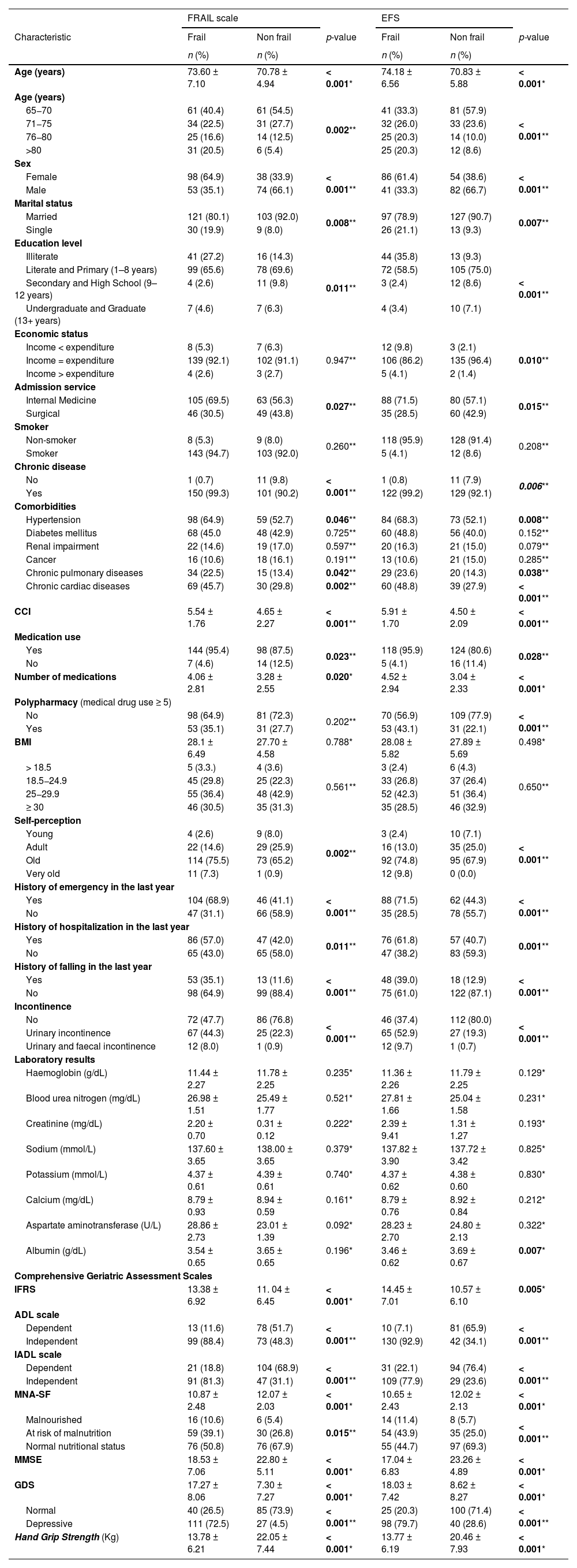This study aimed to determine the prevalence and factors associated with frailty in older hospitalized patients.
MethodsThe point-prevalence study was completed on 263 patients aged 65 and over hospitalized in internal medicine and surgical clinics at a tertiary hospital in Türkiye. Data were collected between July 19th and July 22nd, 2021. A comprehensive geriatric assessment was performed on the participants. The Edmonton Frailty Scale (EFS) and FRAIL scale were used for frailty assessment.
ResultsThe mean age of the individuals was 72.40 ± 6.42, 51.7% were female, and 63.9% were hospitalized in internal medicine and surgical units. The prevalence of frailty was 57.4% according to the FRAIL scale and 46.8% according to EFS. Factors affecting frailty were gender (OR 3.36, 95% CI 1.48–7.64), comorbidity (OR 1.29, 95% CI 1.01–1.64), polypharmacy (OR 0.33, 95% CI 0.13−0.80), history of falling in the last year (OR 3.54, 95% CI 1.34–9.35), incontinence (OR 5.93, 95% CI 2.47–14.27), and functional dependency (ADL, OR 0.65, 95% CI 0.46−0.92; IADL, OR 0.59, 95% CI 0.46−0.76). This model correctly predicted the participants' frailty at 70.5%.
ConclusionsThe importance of frailty, which affects one out of every two hospitalized older persons, to the health care system should not be overlooked. Considering the increasing trend of the aging person population, national and global plans should be made to prevent and manage frailty.
Este estudio tuvo como objetivo determinar la prevalencia y los factores asociados a la fragilidad en pacientes mayores hospitalizados.
MétodosEste estudio de prevalencia puntual se realizó con 263 pacientes de 65 años o mayores hospitalizados en los Servicios de Medicina Interna y Clínicas Quirúrgicas en un hospital terciario en Turquía. Los datos se recopilaron entre el 19 y el 22 de julio de 2021. Se realizó una evaluación geriátrica integral en los participantes. Se utilizaron la escala de fragilidad de Edmonton (EFS) y la escala FRAIL para la evaluación de fragilidad.
ResultadosRespecto a los datos de los pacientes, la edad promedio fue de 72,40 ± 6,42 años y el 51,7% de los pacientes fueron mujeres. Y el 63,9% de estos pacientes fueron hospitalizados en Servicios de Medicina Interna. La prevalencia de fragilidad fue del 57,4% según la escala FRAIL y el 46,8% según la EFS. Los factores que afectan la fragilidad fueron: sexo (OR 3,48, IC 95% 1,42–8,49), edad (OR 9,91, IC 95% 1,99–49,30), comorbilidad (OR 1,33, IC 95% 1,01–1,76), polifarmacia (OR 0,30, IC 95% 0,11−0,79), historial de caídas en el año pasado (OR 3,59, IC 95% 1,25–10,32), incontinencia (OR 10,48, IC 95% 3,66–29,99), y dependencia (ADL OR 0,63, IC 95% 0,43−0,93; IADL OR 0,51, IC 95% 0,38−0,68). Este modelo predijo correctamente la fragilidad de los participantes a una tasa de 75,5%.
ConclusionesNo se debe pasar por alto la importancia de la fragilidad, que afecta a uno de cada dos pacientes mayores hospitalizados, dentro del sistema de atención médica. Teniendo en cuenta la tendencia de crecimiento de la proporción de personas mayores en la población, se deberían hacer planes nacionales y globales para la prevención y gestión de la fragilidad.
Article
Diríjase desde aquí a la web de la >>>FESEMI<<< e inicie sesión mediante el formulario que se encuentra en la barra superior, pulsando sobre el candado.

Una vez autentificado, en la misma web de FESEMI, en el menú superior, elija la opción deseada.

>>>FESEMI<<<









